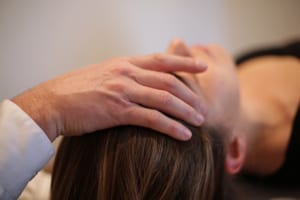Osteopaths are widely known for treating back pain. However Osteopaths can treat well beyond the spine.
From frozen shoulder and Fibromyalgia to headaches and muscle spasms—as an Osteopath, I use a variety of manual techniques, manipulation and allied therapies (like lower level laser therapy and Western Acupuncture) to improve circulation, reduce pain, and enhance the body’s natural healing processes.
That said, Osteopathy is a holistic approach to healthcare and Osteopaths treat the person as well as the presenting symptoms. Therefore, I wouldn’t just look at the physical symptoms a patient is presenting with. A big part of my Osteopathic training is to identify any underlying factors to get to the root cause of the problem, which can sometimes be multifactorial—physical, emotional and nutritional. Doing so may help prevent recurrences and work towards improving a patient’s overall health.
Health conditions an Osteopath can help with
As confirmed by the Advertising Standards Authority, Osteopaths can help with a range of health disorders like:
- Arthritic pain
- Circulatory problems
- Cramp
- Fibromyalgia
- Frozen shoulder/ shoulder and elbow pain/ tennis elbow (lateral epicondylitis arising from associated musculoskeletal conditions of the back and neck, but not isolated occurrences)
- Headache arising from the neck (cervicogenic)
- Joint pains
- Joint pains including hip and knee pain from osteoarthritis as an adjunct to core OA treatments and exercise
- General, acute & chronic backache, back pain (not arising from injury or accident)
- Generalised aches and pains
- Minor sports injuries
- Muscle spasms
- Neuralgia – referred acute pain caused by irritation of a nerve
- Tension and inability to relax
- Rheumatic pain
- Sciatica – presents usually with pain down one or both legs
- Uncomplicated mechanical neck pain (as opposed to neck pain following injury i.e. whiplash).
But perhaps it’s lesser known that Osteopathy and allied therapies can also help with:
1. Migraine prevention
Believed to affect 6 million people in the UK*, Migraines can be a headache in every sense of the word. The complex neurological condition might begin with a painful headache preceded or accompanied by disturbed vision or aura—but migraines can affect the whole body.
Someone suffering with a migraine might see flashing lights and/or zig zag patterns. While others may also experience pins and needles, numb limbs and difficulty in speaking. Sufferers can also encounter dizziness, nausea, vomiting and sensitivity to light, sound and smells.
Medication is one method some turn to, to help control the pain, severity and frequency of attacks. However, as a Naturopath, I try to help my patients achieve emotional and physical wellbeing through natural methods and treatments, allowing their bodies to fight and prevent disease, minimising the need for surgery or drugs.
For example, Osteopathic techniques can help relieve migraine symptoms, whilst understanding and addressing the underlying, sometimes multifactorial, factors involved. While a 2020 systematic review, confirms that complementary therapies, such as Western medical acupuncture (which is also known as dry needling), “is an effective and safe method for migraines”.
2. Rheumatoid Arthritis
Differing to Osteoarthritis, Rheumatoid Arthritis (RA) is an autoimmune disease that causes stiffness and pain because of inflammation in the joints.
According to the NHS, GPs usually treat RA with disease-modifying anti-rheumatic drugs (DMARDs). However there is a growing body of evidence that suggests natural approaches, like exercise, nutrition and Osteopathy—though the use of soft tissue massage—can be useful for pain management.
And, as researchers confirmed in the 2022 edition of the Evidence Based Complementary Alternative Medicine journal, acupuncture can be a ‘beneficial’ non-pharmacological option, too. “Available evidence suggests that acupuncture is beneficial for relieving pain and ameliorating quality of life and health index in patients with RA,” researchers stated. “Thereby, it should be available as an adjunctive nonpharmacological treatment in rehabilitation programmes.”
Get in touch
If you are suffering with any aches or pains don’t suffer in silence. Schedule a consultation either online, via phone or by sending an email. Osteopath and Naturopath Robin Kiashek holds clinics on Mondays, Wednesdays and Fridays.
*https://www.nhs.uk/conditions/migraine/
**https://gutscharity.org.uk/wp-content/uploads/2016/08/DigestingTheFactsReport.pdf
***https://www.nlg.nhs.uk/resources/gastrointestinal-conditions/


 For me, within a clinical setting, I like to use the analogy of ‘The Dripping Tap Syndrome’. People will often have a small twinge or niggle of pain (a dripping tap over a glass scenario) which progressively starts to irritate that little bit more frequently (the glass starts to fill up). This can be over a period of weeks, months or even years. The analogical drip ultimately starts happening more often until eventually the final drop causes the glass to overflow and the patient experiences a significant increase in pain (commonly known as ‘acute’ pain). This ‘final drop’ can be an everyday event – maybe a sneeze, bending forward, a certain slight move etc
For me, within a clinical setting, I like to use the analogy of ‘The Dripping Tap Syndrome’. People will often have a small twinge or niggle of pain (a dripping tap over a glass scenario) which progressively starts to irritate that little bit more frequently (the glass starts to fill up). This can be over a period of weeks, months or even years. The analogical drip ultimately starts happening more often until eventually the final drop causes the glass to overflow and the patient experiences a significant increase in pain (commonly known as ‘acute’ pain). This ‘final drop’ can be an everyday event – maybe a sneeze, bending forward, a certain slight move etc Ultimately I take a holistic approach to any health issue and, to go back to the analogy, find out why that dripping tap first occurred. As somebody who has undertaken extensive training from Osteopathy and Naturopathy, Post graduate studies in NeuroLinguistic Programming (NLP)/Life Coaching, Western Acupuncture, The Perrin Technique for Chronic Fatigue Syndrome and Low Level Laser Therapy.
Ultimately I take a holistic approach to any health issue and, to go back to the analogy, find out why that dripping tap first occurred. As somebody who has undertaken extensive training from Osteopathy and Naturopathy, Post graduate studies in NeuroLinguistic Programming (NLP)/Life Coaching, Western Acupuncture, The Perrin Technique for Chronic Fatigue Syndrome and Low Level Laser Therapy.